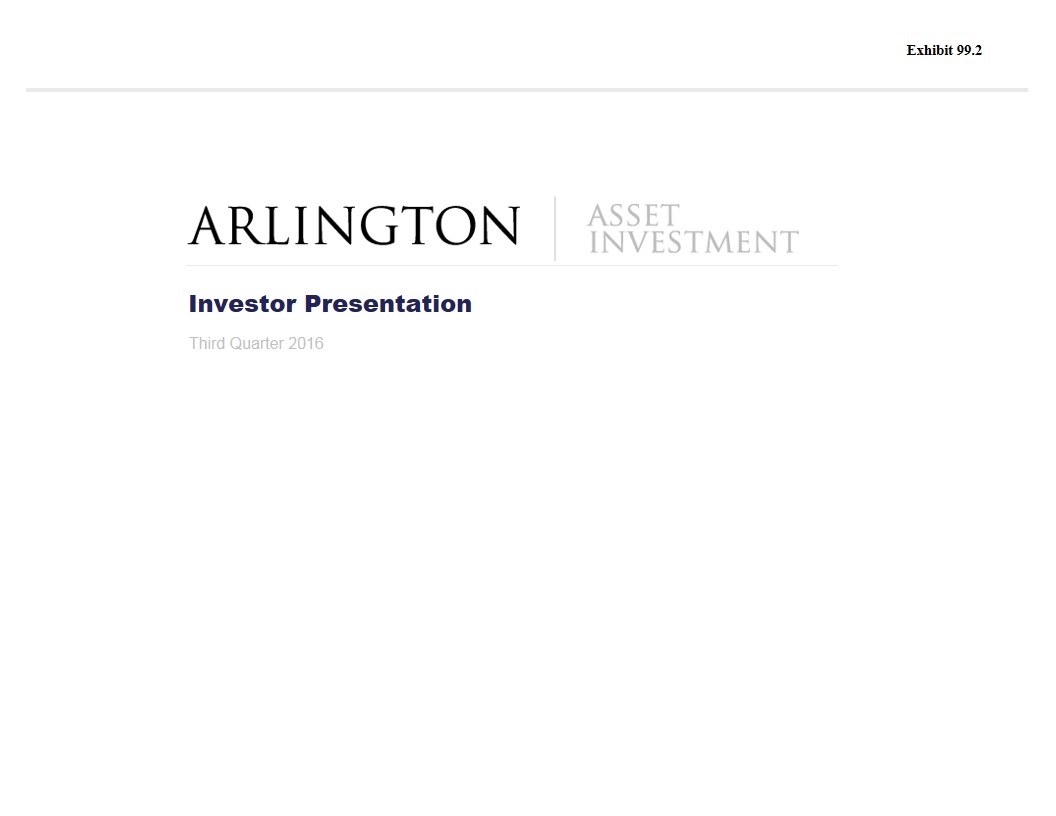
Investor Presentation Third Quarter 2016 Exhibit 99.2
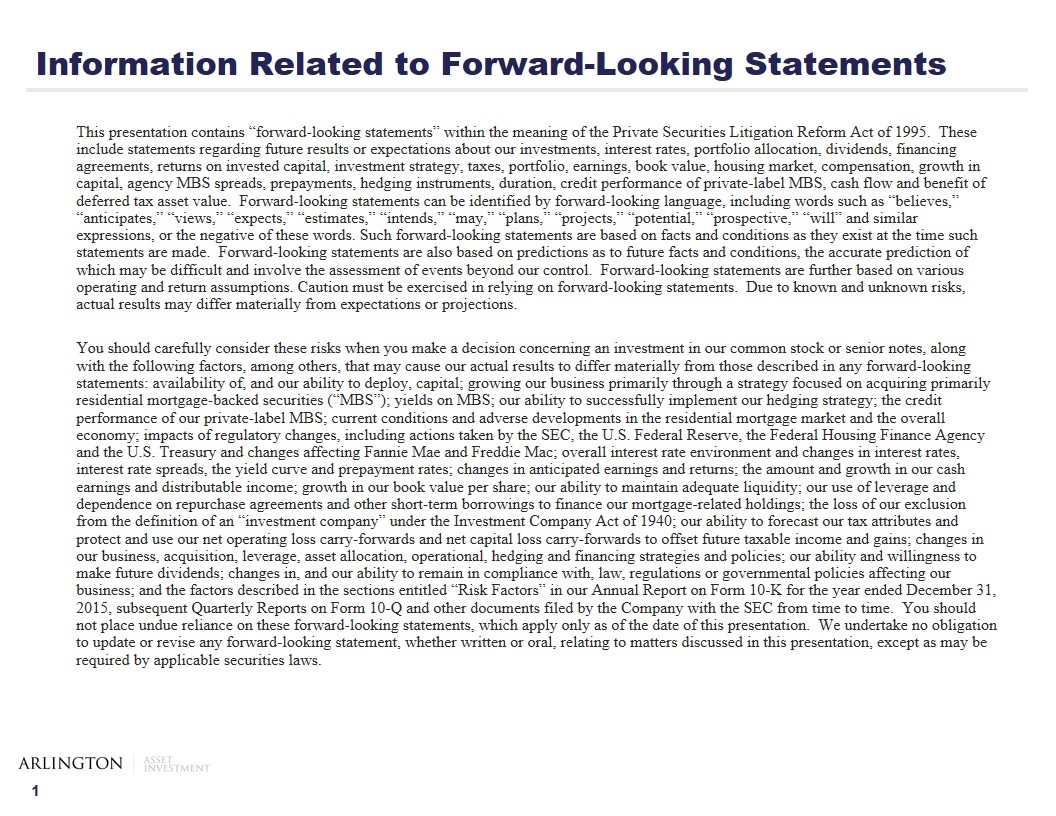
Information Related to Forward-Looking Statements This presentation contains “forward-looking statements” within the meaning of the Private Securities Litigation Reform Act of 1995. These include statements regarding future results or expectations about our investments, interest rates, portfolio allocation, dividends, financing agreements, returns on invested capital, investment strategy, taxes, portfolio, earnings, book value, housing market, compensation, growth in capital, agency MBS spreads, prepayments, hedging instruments, duration, credit performance of private-label MBS, cash flow and benefit of deferred tax asset value. Forward-looking statements can be identified by forward-looking language, including words such as “believes,” “anticipates,” “views,” “expects,” “estimates,” “intends,” “may,” “plans,” “projects,” “potential,” “prospective,” “will” and similar expressions, or the negative of these words. Such forward-looking statements are based on facts and conditions as they exist at the time such statements are made. Forward-looking statements are also based on predictions as to future facts and conditions, the accurate prediction of which may be difficult and involve the assessment of events beyond our control. Forward-looking statements are further based on various operating and return assumptions. Caution must be exercised in relying on forward-looking statements. Due to known and unknown risks, actual results may differ materially from expectations or projections. You should carefully consider these risks when you make a decision concerning an investment in our common stock or senior notes, along with the following factors, among others, that may cause our actual results to differ materially from those described in any forward-looking statements: availability of, and our ability to deploy, capital; growing our business primarily through a strategy focused on acquiring primarily residential mortgage-backed securities (“MBS”); yields on MBS; our ability to successfully implement our hedging strategy; the credit performance of our private-label MBS; current conditions and adverse developments in the residential mortgage market and the overall economy; impacts of regulatory changes, including actions taken by the SEC, the U.S. Federal Reserve, the Federal Housing Finance Agency and the U.S. Treasury and changes affecting Fannie Mae and Freddie Mac; overall interest rate environment and changes in interest rates, interest rate spreads, the yield curve and prepayment rates; changes in anticipated earnings and returns; the amount and growth in our cash earnings and distributable income; growth in our book value per share; our ability to maintain adequate liquidity; our use of leverage and dependence on repurchase agreements and other short-term borrowings to finance our mortgage-related holdings; the loss of our exclusion from the definition of an “investment company” under the Investment Company Act of 1940; our ability to forecast our tax attributes and protect and use our net operating loss carry-forwards and net capital loss carry-forwards to offset future taxable income and gains; changes in our business, acquisition, leverage, asset allocation, operational, hedging and financing strategies and policies; our ability and willingness to make future dividends; changes in, and our ability to remain in compliance with, law, regulations or governmental policies affecting our business; and the factors described in the sections entitled “Risk Factors” in our Annual Report on Form 10-K for the year ended December 31, 2015, subsequent Quarterly Reports on Form 10-Q and other documents filed by the Company with the SEC from time to time. You should not place undue reliance on these forward-looking statements, which apply only as of the date of this presentation. We undertake no obligation to update or revise any forward-looking statement, whether written or oral, relating to matters discussed in this presentation, except as may be required by applicable securities laws.
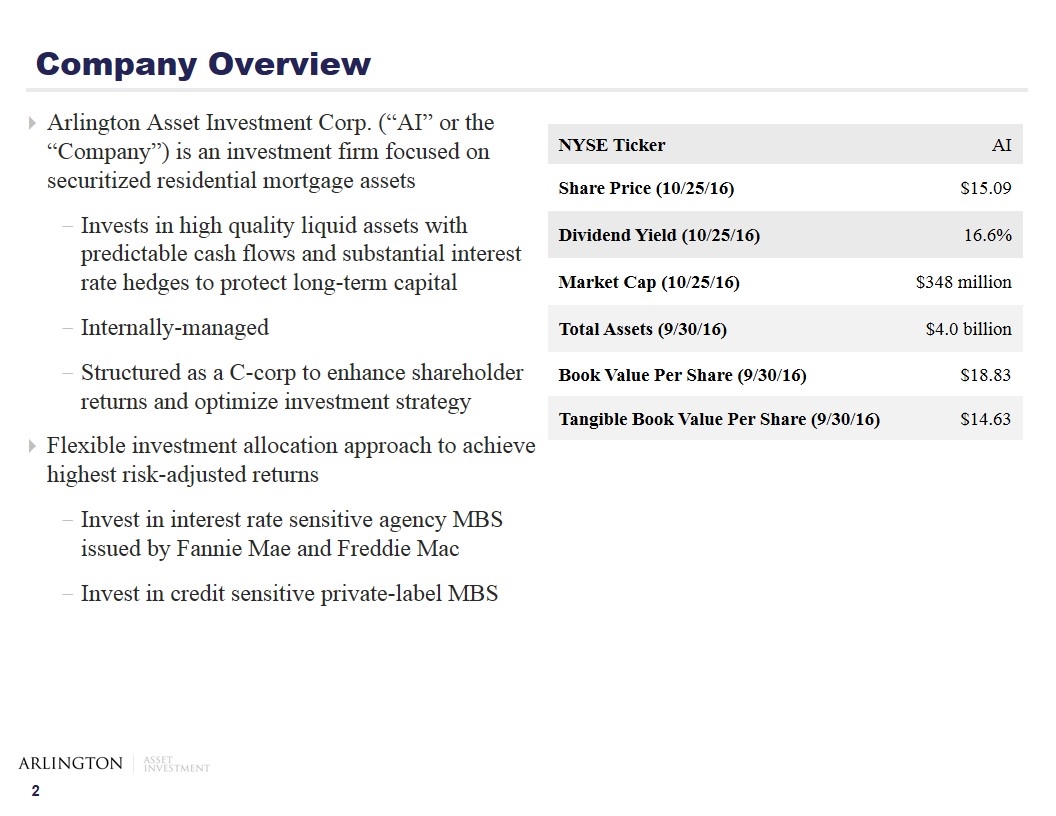
Company Overview Arlington Asset Investment Corp. (“AI” or the “Company”) is an investment firm focused on securitized residential mortgage assets Invests in high quality liquid assets with predictable cash flows and substantial interest rate hedges to protect long-term capital Internally-managed Structured as a C-corp to enhance shareholder returns and optimize investment strategy Flexible investment allocation approach to achieve highest risk-adjusted returns Invest in interest rate sensitive agency MBS issued by Fannie Mae and Freddie Mac Invest in credit sensitive private-label MBS NYSE Ticker AI Share Price (10/25/16) $15.09 Dividend Yield (10/25/16) 16.6% Market Cap (10/25/16) $348 million Total Assets (9/30/16) $4.0 billion Book Value Per Share (9/30/16) $18.83 Tangible Book Value Per Share (9/30/16) $14.63
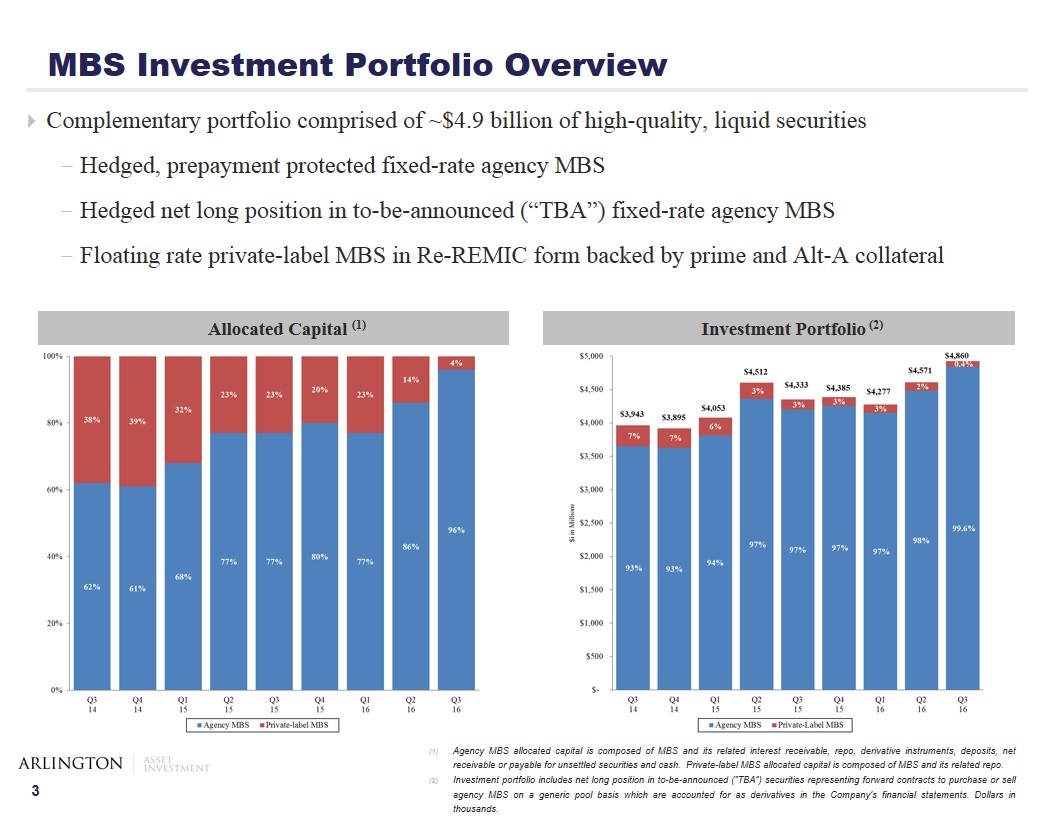
Complementary portfolio comprised of ~$4.9 billion of high-quality, liquid securities Hedged, prepayment protected fixed-rate agency MBS Hedged net long position in to-be-announced (“TBA”) fixed-rate agency MBS Floating rate private-label MBS in Re-REMIC form backed by prime and Alt-A collateral MBS Investment Portfolio Overview Agency MBS allocated capital is composed of MBS and its related interest receivable, repo, derivative instruments, deposits, net receivable or payable for unsettled securities and cash. Private-label MBS allocated capital is composed of MBS and its related repo. Investment portfolio includes net long position in to-be-announced (“TBA”) securities representing forward contracts to purchase or sell agency MBS on a generic pool basis which are accounted for as derivatives in the Company’s financial statements. Dollars in thousands. Investment Portfolio (2) Allocated Capital (1)
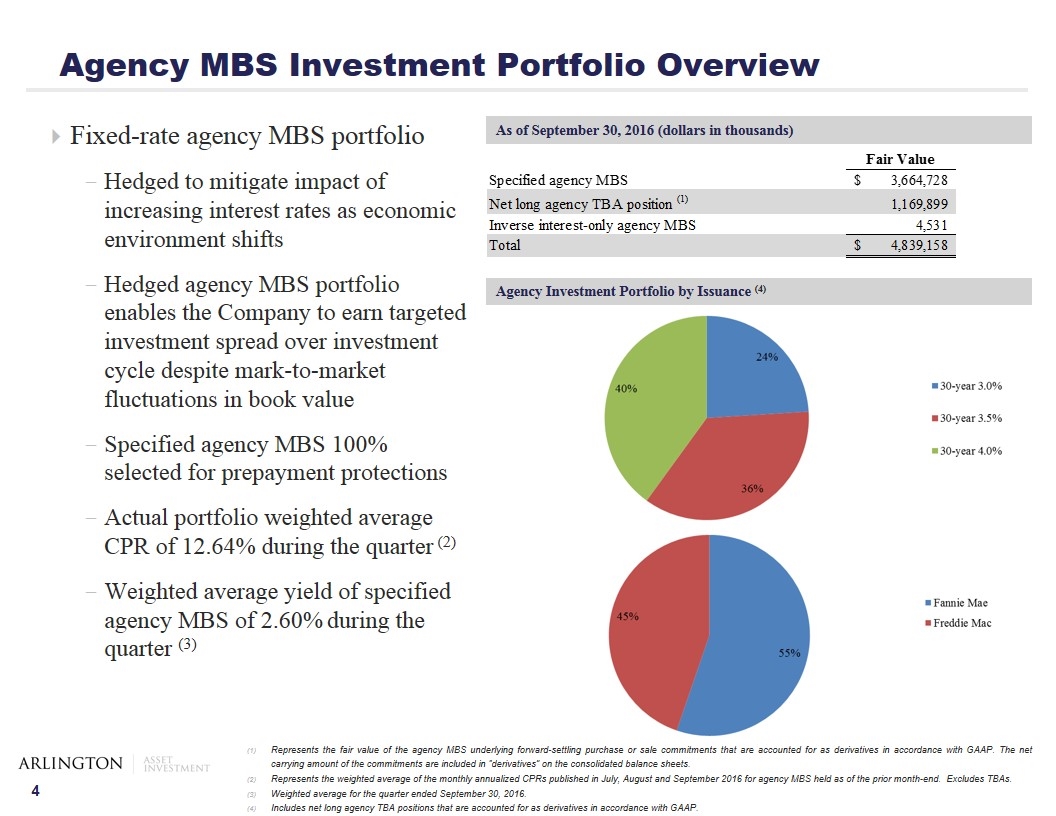
Fixed-rate agency MBS portfolio Hedged to mitigate impact of increasing interest rates as economic environment shifts Hedged agency MBS portfolio enables the Company to earn targeted investment spread over investment cycle despite mark-to-market fluctuations in book value Specified agency MBS 100% selected for prepayment protections Actual portfolio weighted average CPR of 12.64% during the quarter (2) Weighted average yield of specified agency MBS of 2.60% during the quarter (3) Agency MBS Investment Portfolio Overview As of September 30, 2016 (dollars in thousands) Represents the fair value of the agency MBS underlying forward-settling purchase or sale commitments that are accounted for as derivatives in accordance with GAAP. The net carrying amount of the commitments are included in “derivatives” on the consolidated balance sheets. Represents the weighted average of the monthly annualized CPRs published in July, August and September 2016 for agency MBS held as of the prior month-end. Excludes TBAs. Weighted average for the quarter ended September 30, 2016. Includes net long agency TBA positions that are accounted for as derivatives in accordance with GAAP. Agency Investment Portfolio by Issuance (4)
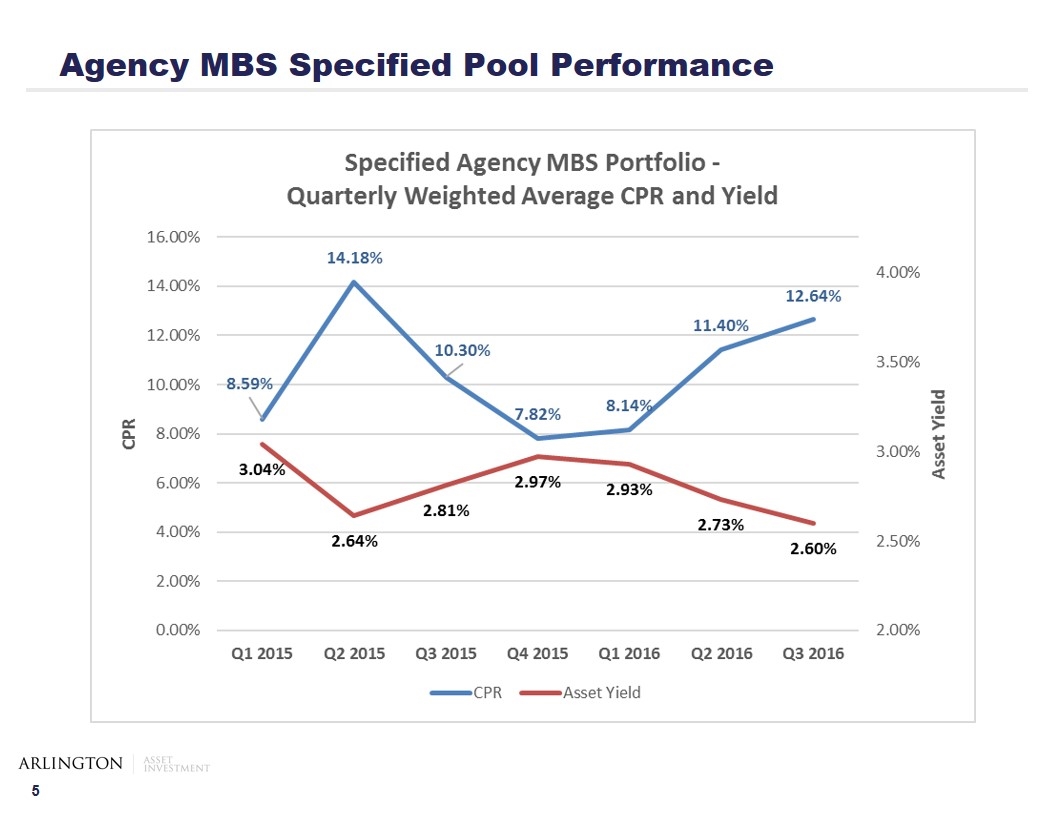
Agency MBS Specified Pool Performance
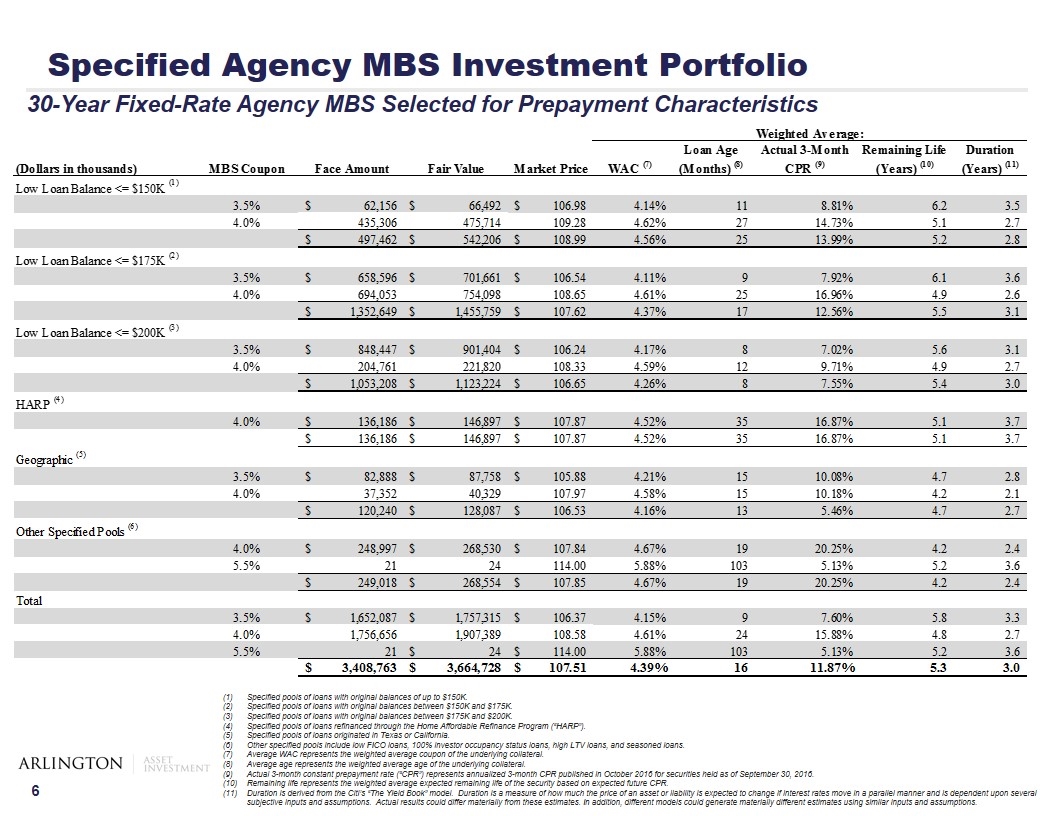
Specified Agency MBS Investment Portfolio Specified pools of loans with original balances of up to $150K. Specified pools of loans with original balances between $150K and $175K. Specified pools of loans with original balances between $175K and $200K. Specified pools of loans refinanced through the Home Affordable Refinance Program (“HARP”). Specified pools of loans originated in Texas or California. Other specified pools include low FICO loans, 100% investor occupancy status loans, high LTV loans, and seasoned loans. Average WAC represents the weighted average coupon of the underlying collateral. Average age represents the weighted average age of the underlying collateral. Actual 3-month constant prepayment rate (“CPR”) represents annualized 3-month CPR published in October 2016 for securities held as of September 30, 2016. Remaining life represents the weighted average expected remaining life of the security based on expected future CPR. Duration is derived from the Citi’s “The Yield Book” model. Duration is a measure of how much the price of an asset or liability is expected to change if interest rates move in a parallel manner and is dependent upon several subjective inputs and assumptions. Actual results could differ materially from these estimates. In addition, different models could generate materially different estimates using similar inputs and assumptions. 30-Year Fixed-Rate Agency MBS Selected for Prepayment Characteristics
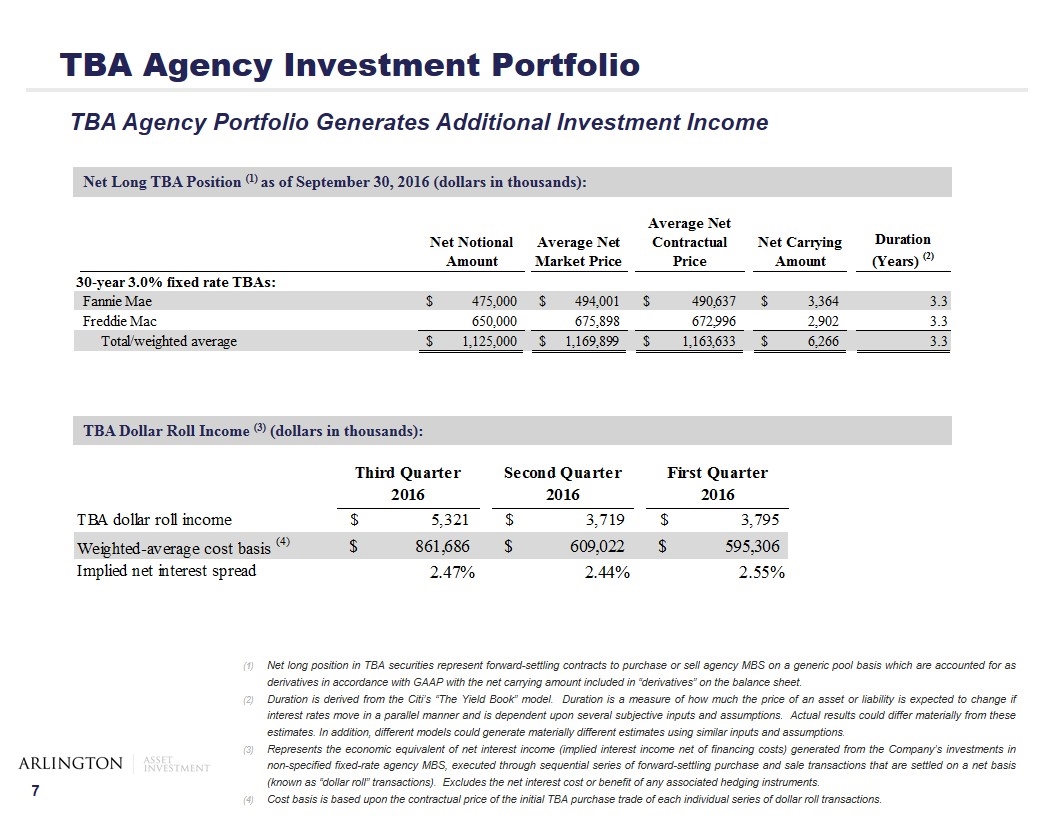
TBA Agency Investment Portfolio Net long position in TBA securities represent forward-settling contracts to purchase or sell agency MBS on a generic pool basis which are accounted for as derivatives in accordance with GAAP with the net carrying amount included in “derivatives” on the balance sheet. Duration is derived from the Citi’s “The Yield Book” model. Duration is a measure of how much the price of an asset or liability is expected to change if interest rates move in a parallel manner and is dependent upon several subjective inputs and assumptions. Actual results could differ materially from these estimates. In addition, different models could generate materially different estimates using similar inputs and assumptions. Represents the economic equivalent of net interest income (implied interest income net of financing costs) generated from the Company’s investments in non-specified fixed-rate agency MBS, executed through sequential series of forward-settling purchase and sale transactions that are settled on a net basis (known as “dollar roll” transactions). Excludes the net interest cost or benefit of any associated hedging instruments. Cost basis is based upon the contractual price of the initial TBA purchase trade of each individual series of dollar roll transactions. TBA Agency Portfolio Generates Additional Investment Income Net Long TBA Position (1) as of September 30, 2016 (dollars in thousands): TBA Dollar Roll Income (3) (dollars in thousands):
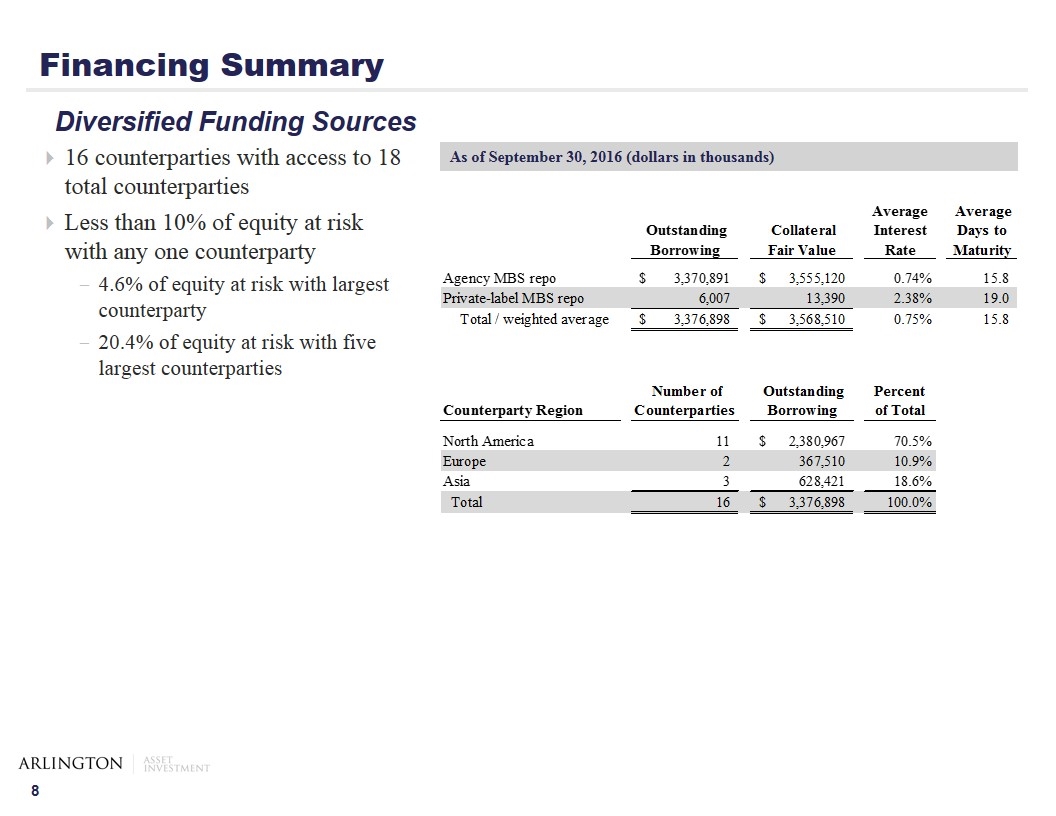
Financing Summary 16 counterparties with access to 18 total counterparties Less than 10% of equity at risk with any one counterparty 4.6% of equity at risk with largest counterparty 20.4% of equity at risk with five largest counterparties Diversified Funding Sources As of September 30, 2016 (dollars in thousands)
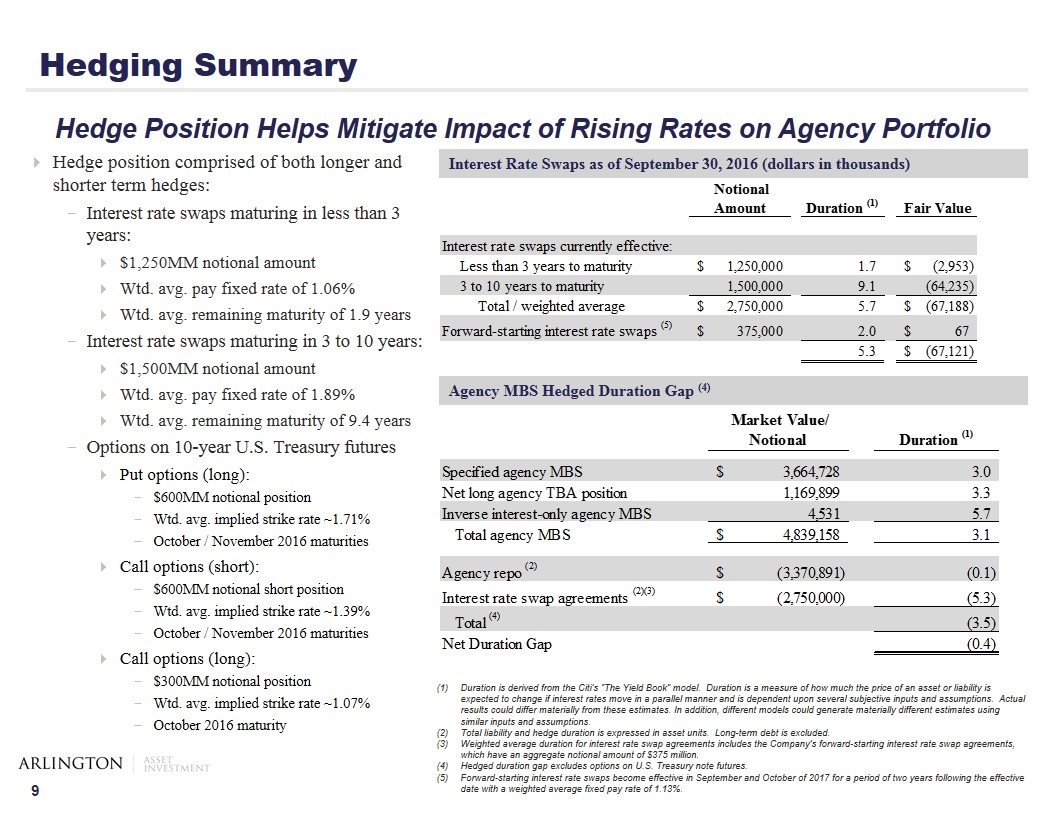
Hedge position comprised of both longer and shorter term hedges: Interest rate swaps maturing in less than 3 years: $1,250MM notional amount Wtd. avg. pay fixed rate of 1.06% Wtd. avg. remaining maturity of 1.9 years Interest rate swaps maturing in 3 to 10 years: $1,500MM notional amount Wtd. avg. pay fixed rate of 1.89% Wtd. avg. remaining maturity of 9.4 years Options on 10-year U.S. Treasury futures Put options (long): $600MM notional position Wtd. avg. implied strike rate ~1.71% October / November 2016 maturities Call options (short): $600MM notional short position Wtd. avg. implied strike rate ~1.39% October / November 2016 maturities Call options (long): $300MM notional position Wtd. avg. implied strike rate ~1.07% October 2016 maturity Hedging Summary Hedge Position Helps Mitigate Impact of Rising Rates on Agency Portfolio Interest Rate Swaps as of September 30, 2016 (dollars in thousands) Duration is derived from the Citi’s “The Yield Book” model. Duration is a measure of how much the price of an asset or liability is expected to change if interest rates move in a parallel manner and is dependent upon several subjective inputs and assumptions. Actual results could differ materially from these estimates. In addition, different models could generate materially different estimates using similar inputs and assumptions. Total liability and hedge duration is expressed in asset units. Long-term debt is excluded. Weighted average duration for interest rate swap agreements includes the Company’s forward-starting interest rate swap agreements, which have an aggregate notional amount of $375 million. Hedged duration gap excludes options on U.S. Treasury note futures. Forward-starting interest rate swaps become effective in September and October of 2017 for a period of two years following the effective date with a weighted average fixed pay rate of 1.13%. Agency MBS Hedged Duration Gap (4)
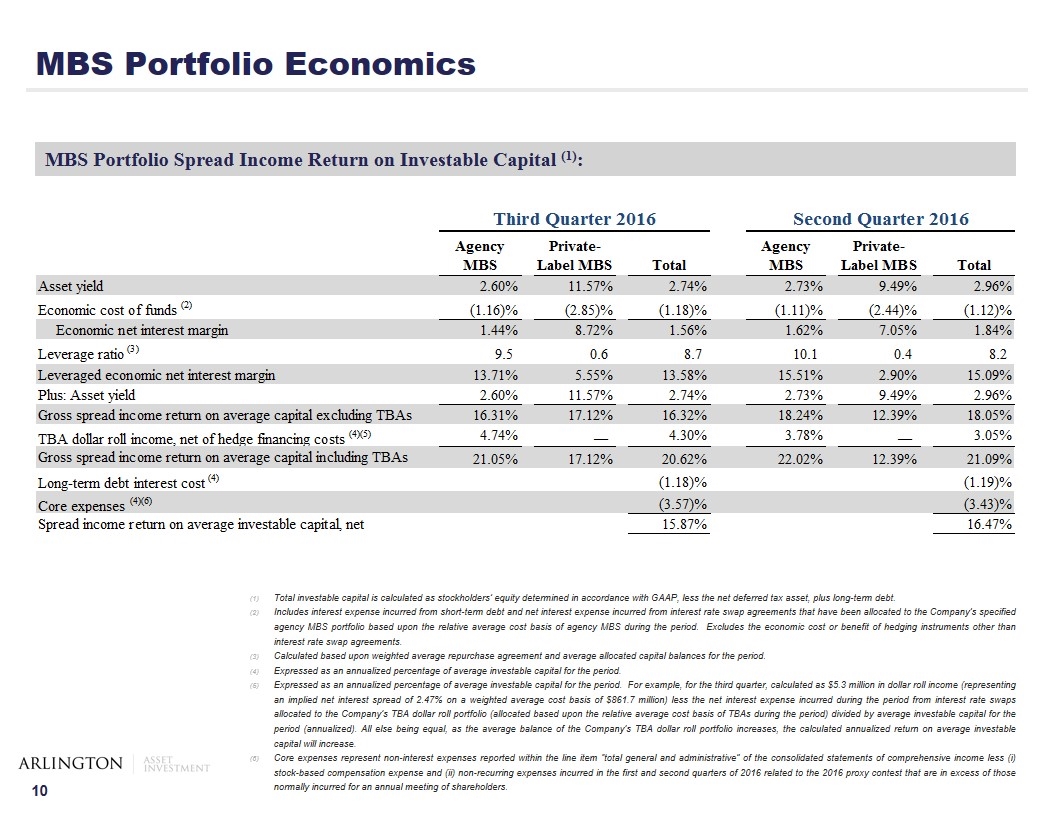
MBS Portfolio Economics MBS Portfolio Spread Income Return on Investable Capital (1): Total investable capital is calculated as stockholders’ equity determined in accordance with GAAP, less the net deferred tax asset, plus long-term debt. Includes interest expense incurred from short-term debt and net interest expense incurred from interest rate swap agreements that have been allocated to the Company’s specified agency MBS portfolio based upon the relative average cost basis of agency MBS during the period. Excludes the economic cost or benefit of hedging instruments other than interest rate swap agreements. Calculated based upon weighted average repurchase agreement and average allocated capital balances for the period. Expressed as an annualized percentage of average investable capital for the period. Expressed as an annualized percentage of average investable capital for the period. For example, for the third quarter, calculated as $5.3 million in dollar roll income (representing an implied net interest spread of 2.47% on a weighted average cost basis of $861.7 million) less the net interest expense incurred during the period from interest rate swaps allocated to the Company’s TBA dollar roll portfolio (allocated based upon the relative average cost basis of TBAs during the period) divided by average investable capital for the period (annualized). All else being equal, as the average balance of the Company’s TBA dollar roll portfolio increases, the calculated annualized return on average investable capital will increase. Core expenses represent non-interest expenses reported within the line item “total general and administrative” of the consolidated statements of comprehensive income less (i) stock-based compensation expense and (ii) non-recurring expenses incurred in the first and second quarters of 2016 related to the 2016 proxy contest that are in excess of those normally incurred for an annual meeting of shareholders.
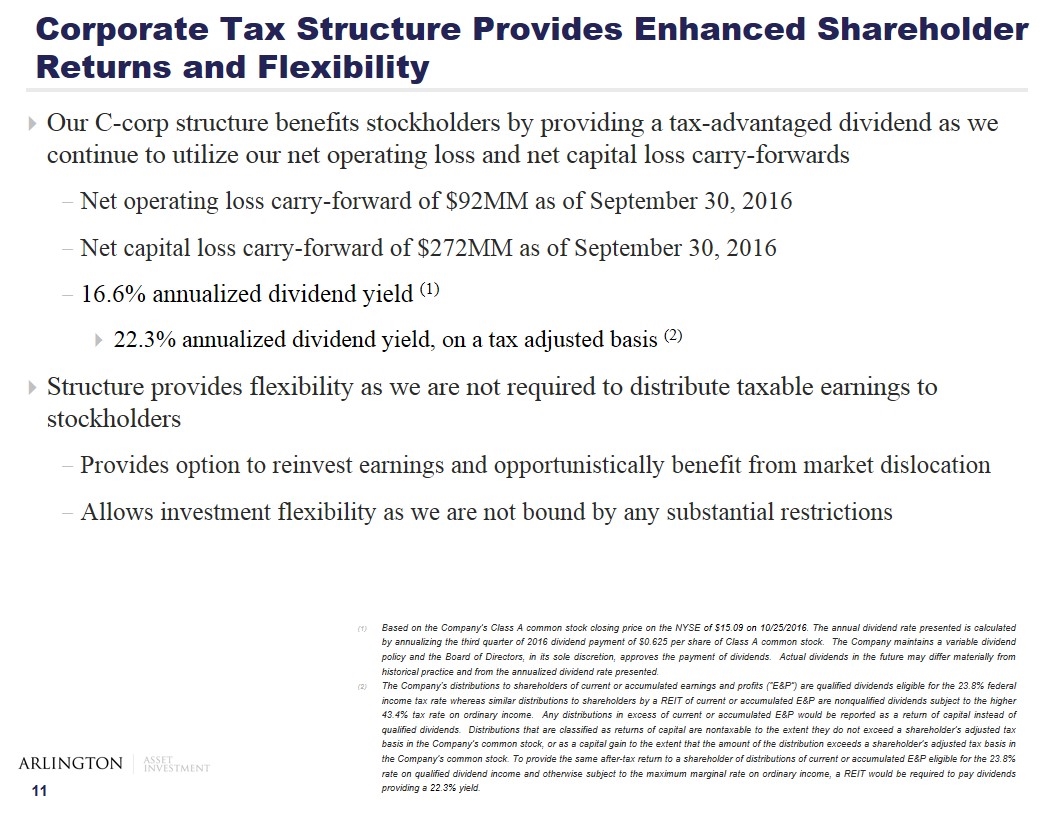
Our C-corp structure benefits stockholders by providing a tax-advantaged dividend as we continue to utilize our net operating loss and net capital loss carry-forwards Net operating loss carry-forward of $92MM as of September 30, 2016 Net capital loss carry-forward of $272MM as of September 30, 2016 16.6% annualized dividend yield (1) 22.3% annualized dividend yield, on a tax adjusted basis (2) Structure provides flexibility as we are not required to distribute taxable earnings to stockholders Provides option to reinvest earnings and opportunistically benefit from market dislocation Allows investment flexibility as we are not bound by any substantial restrictions Based on the Company’s Class A common stock closing price on the NYSE of $15.09 on 10/25/2016. The annual dividend rate presented is calculated by annualizing the third quarter of 2016 dividend payment of $0.625 per share of Class A common stock. The Company maintains a variable dividend policy and the Board of Directors, in its sole discretion, approves the payment of dividends. Actual dividends in the future may differ materially from historical practice and from the annualized dividend rate presented. The Company's distributions to shareholders of current or accumulated earnings and profits (“E&P”) are qualified dividends eligible for the 23.8% federal income tax rate whereas similar distributions to shareholders by a REIT of current or accumulated E&P are nonqualified dividends subject to the higher 43.4% tax rate on ordinary income. Any distributions in excess of current or accumulated E&P would be reported as a return of capital instead of qualified dividends. Distributions that are classified as returns of capital are nontaxable to the extent they do not exceed a shareholder’s adjusted tax basis in the Company’s common stock, or as a capital gain to the extent that the amount of the distribution exceeds a shareholder’s adjusted tax basis in the Company’s common stock. To provide the same after-tax return to a shareholder of distributions of current or accumulated E&P eligible for the 23.8% rate on qualified dividend income and otherwise subject to the maximum marginal rate on ordinary income, a REIT would be required to pay dividends providing a 22.3% yield. Corporate Tax Structure Provides Enhanced Shareholder Returns and Flexibility
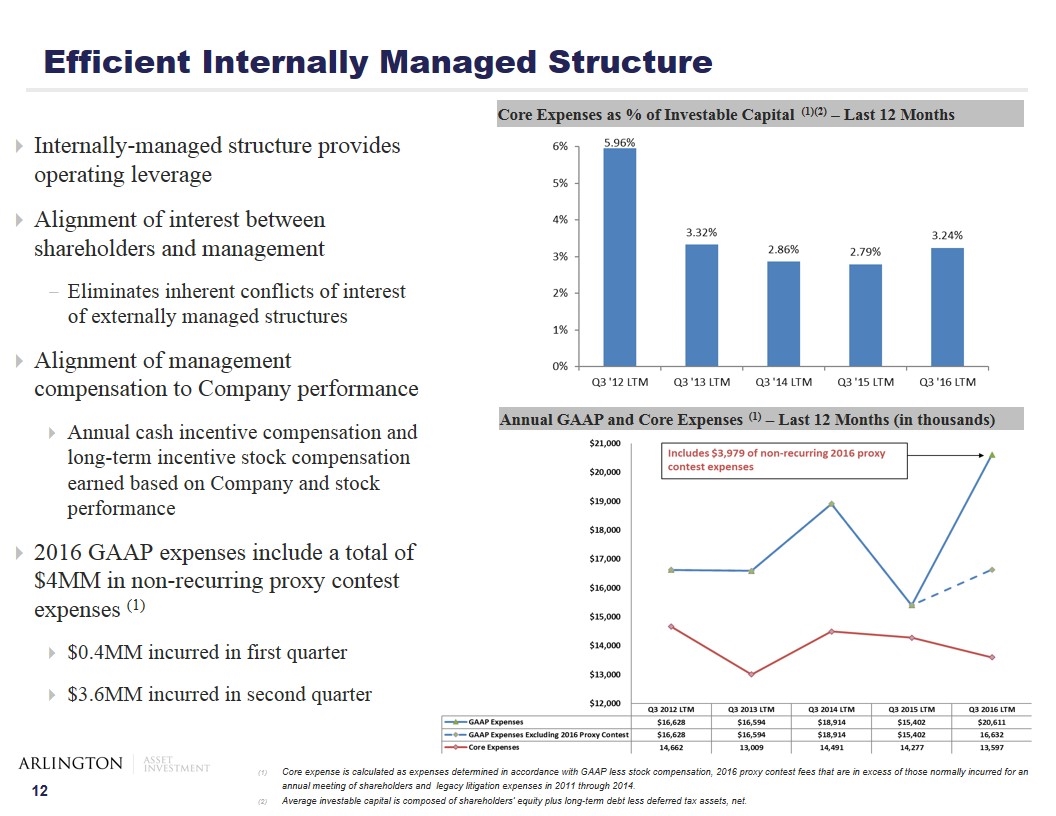
Internally-managed structure provides operating leverage Alignment of interest between shareholders and management Eliminates inherent conflicts of interest of externally managed structures Alignment of management compensation to Company performance Annual cash incentive compensation and long-term incentive stock compensation earned based on Company and stock performance 2016 GAAP expenses include a total of $4MM in non-recurring proxy contest expenses (1) $0.4MM incurred in first quarter $3.6MM incurred in second quarter Core Expenses as % of Investable Capital (1)(2) – Last 12 Months Efficient Internally Managed Structure Core expense is calculated as expenses determined in accordance with GAAP less stock compensation, 2016 proxy contest fees that are in excess of those normally incurred for an annual meeting of shareholders and legacy litigation expenses in 2011 through 2014. Average investable capital is composed of shareholders’ equity plus long-term debt less deferred tax assets, net. Annual GAAP and Core Expenses (1) – Last 12 Months (in thousands)
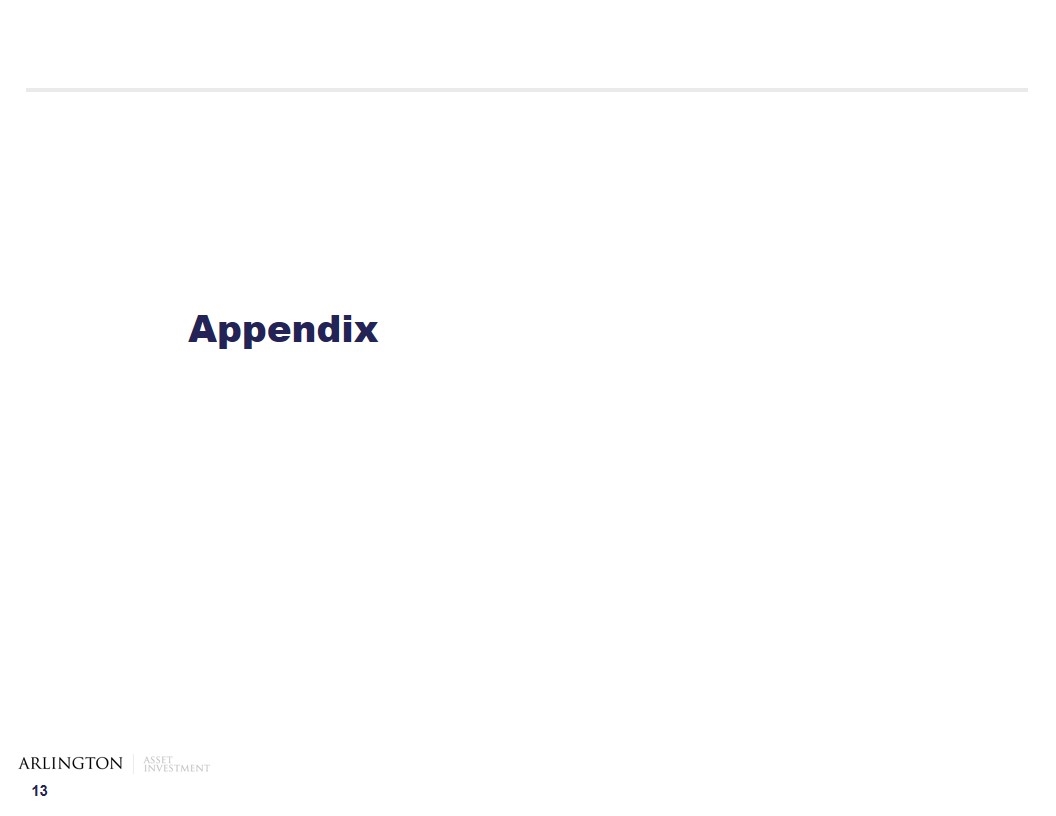
Appendix
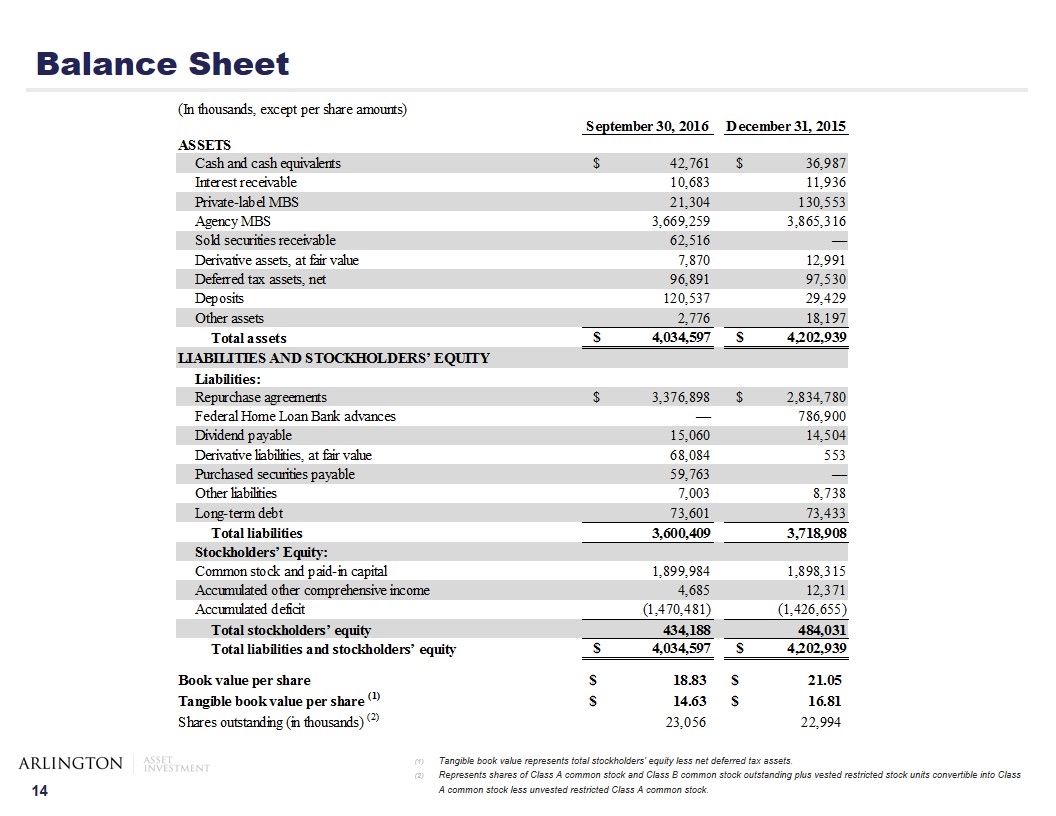
Balance Sheet Tangible book value represents total stockholders' equity less net deferred tax assets. Represents shares of Class A common stock and Class B common stock outstanding plus vested restricted stock units convertible into Class A common stock less unvested restricted Class A common stock.

Statement of Comprehensive Income
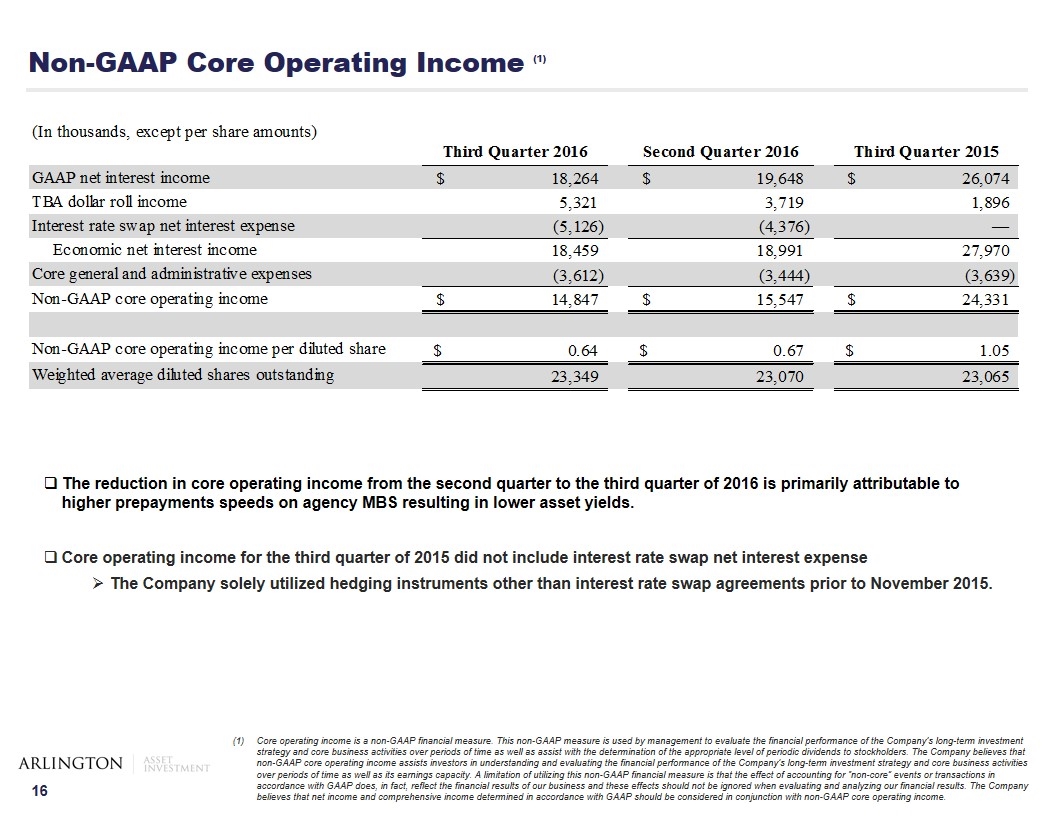
Non-GAAP Core Operating Income (1) Core operating income is a non-GAAP financial measure. This non-GAAP measure is used by management to evaluate the financial performance of the Company’s long-term investment strategy and core business activities over periods of time as well as assist with the determination of the appropriate level of periodic dividends to stockholders. The Company believes that non-GAAP core operating income assists investors in understanding and evaluating the financial performance of the Company’s long-term investment strategy and core business activities over periods of time as well as its earnings capacity. A limitation of utilizing this non-GAAP financial measure is that the effect of accounting for “non-core” events or transactions in accordance with GAAP does, in fact, reflect the financial results of our business and these effects should not be ignored when evaluating and analyzing our financial results. The Company believes that net income and comprehensive income determined in accordance with GAAP should be considered in conjunction with non-GAAP core operating income. The reduction in core operating income from the second quarter to the third quarter of 2016 is primarily attributable to higher prepayments speeds on agency MBS resulting in lower asset yields. Core operating income for the third quarter of 2015 did not include interest rate swap net interest expense The Company solely utilized hedging instruments other than interest rate swap agreements prior to November 2015.

Non-GAAP Core Operating Income (1) Core operating income is a non-GAAP financial measure. This non-GAAP measure is used by management to evaluate the financial performance of the Company’s long-term investment strategy and core business activities over periods of time as well as assist with the determination of the appropriate level of periodic dividends to stockholders. The Company believes that non-GAAP core operating income assists investors in understanding and evaluating the financial performance of the Company’s long-term investment strategy and core business activities over periods of time as well as its earnings capacity. A limitation of utilizing this non-GAAP financial measure is that the effect of accounting for “non-core” events or transactions in accordance with GAAP does, in fact, reflect the financial results of our business and these effects should not be ignored when evaluating and analyzing our financial results. The Company believes that net income and comprehensive income determined in accordance with GAAP should be considered in conjunction with non-GAAP core operating income. Reconciliation of GAAP pre-tax net income to non-GAAP core operating income (dollars in thousands):
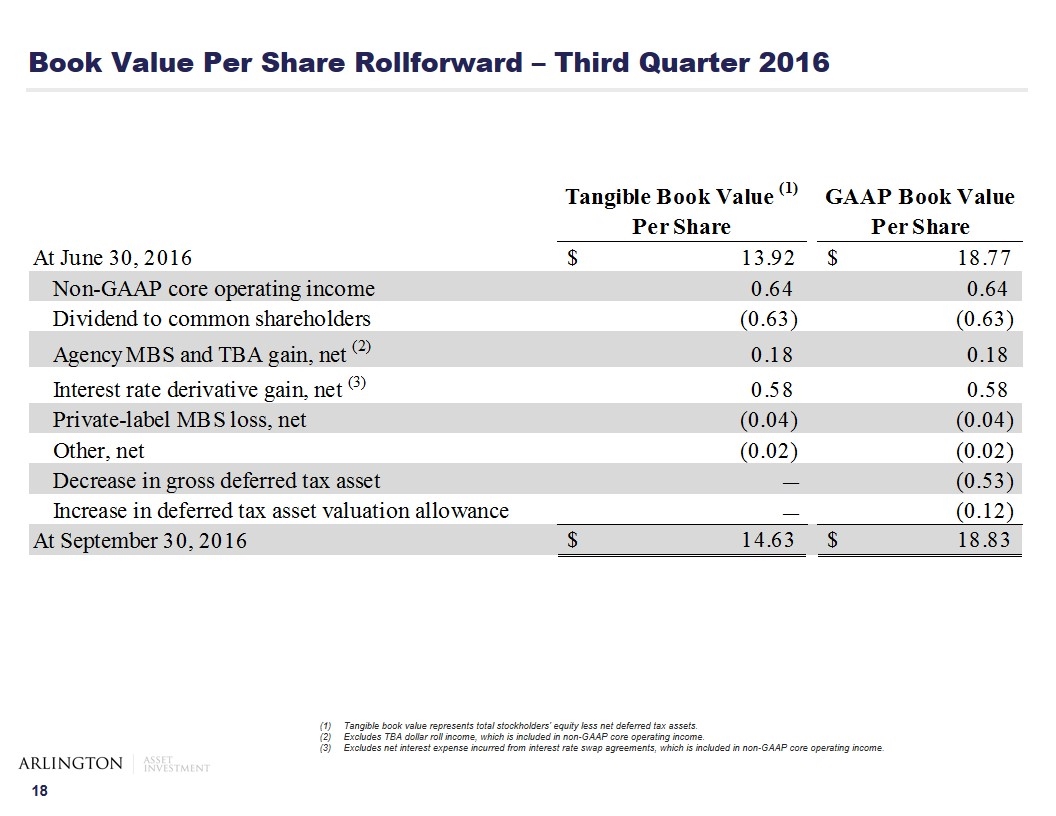
Book Value Per Share Rollforward – Third Quarter 2016 Tangible book value represents total stockholders' equity less net deferred tax assets. Excludes TBA dollar roll income, which is included in non-GAAP core operating income. Excludes net interest expense incurred from interest rate swap agreements, which is included in non-GAAP core operating income.
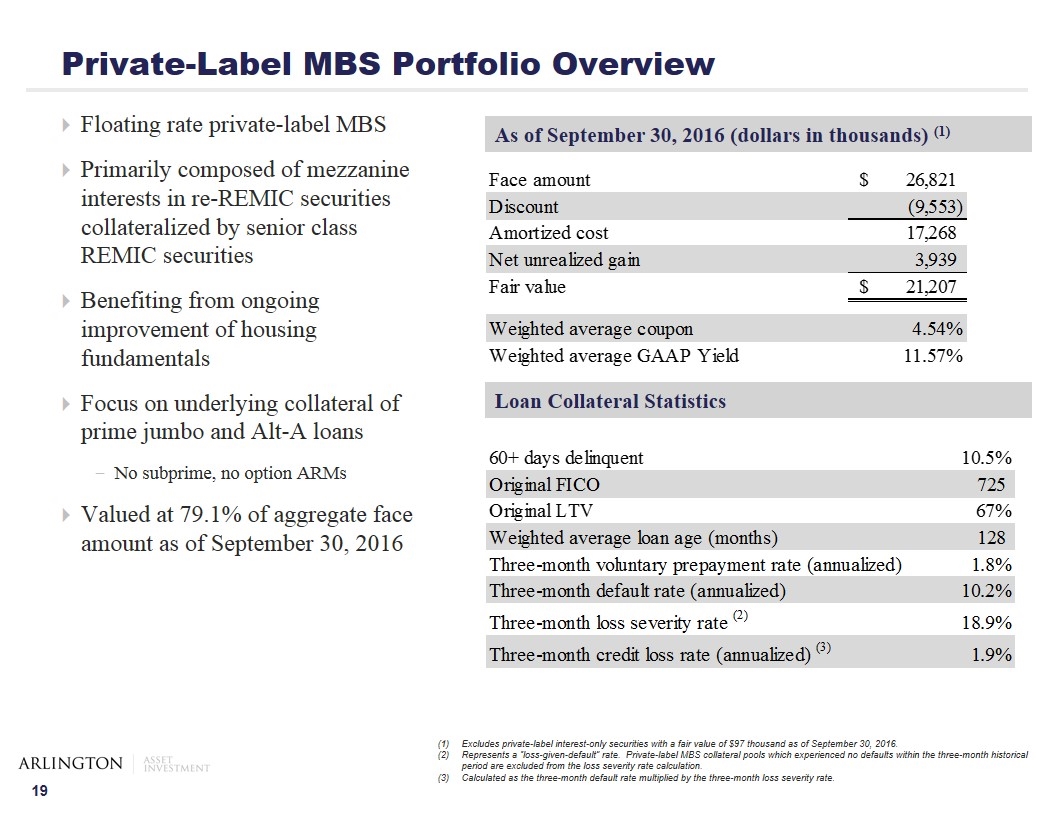
Floating rate private-label MBS Primarily composed of mezzanine interests in re-REMIC securities collateralized by senior class REMIC securities Benefiting from ongoing improvement of housing fundamentals Focus on underlying collateral of prime jumbo and Alt-A loans No subprime, no option ARMs Valued at 79.1% of aggregate face amount as of September 30, 2016 Private-Label MBS Portfolio Overview As of September 30, 2016 (dollars in thousands) (1) Loan Collateral Statistics Excludes private-label interest-only securities with a fair value of $97 thousand as of September 30, 2016. Represents a “loss-given-default” rate. Private-label MBS collateral pools which experienced no defaults within the three-month historical period are excluded from the loss severity rate calculation. Calculated as the three-month default rate multiplied by the three-month loss severity rate.
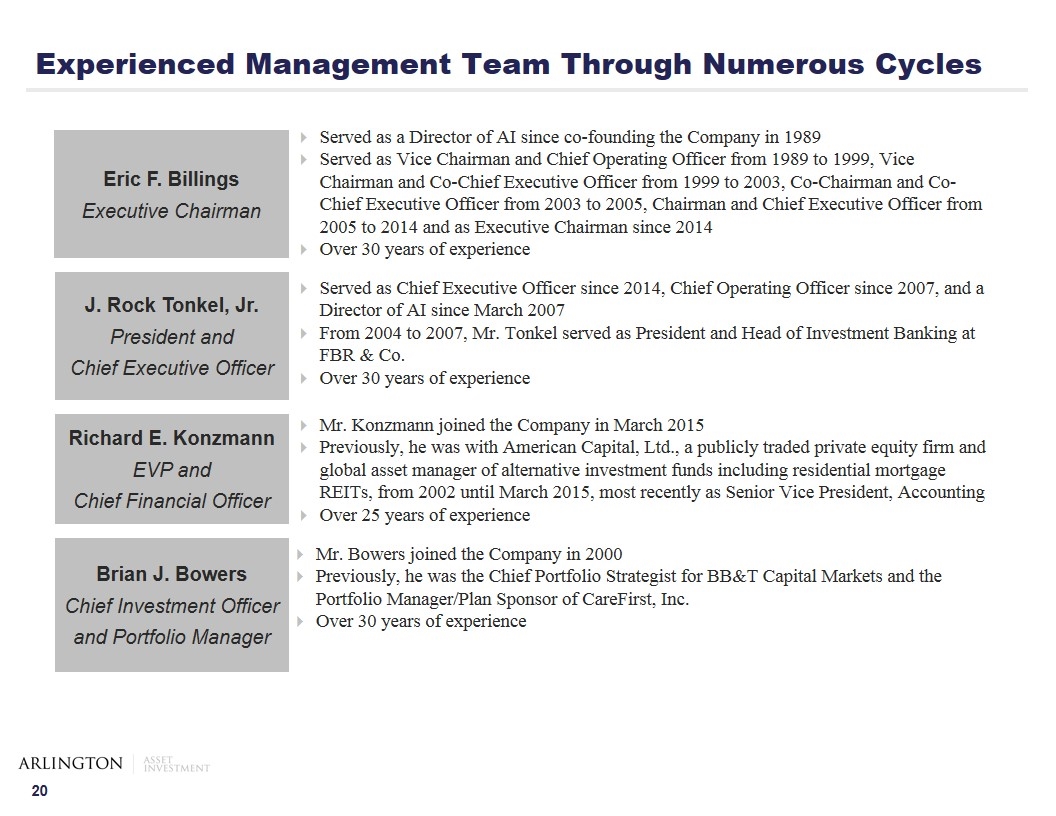
Served as a Director of AI since co-founding the Company in 1989 Served as Vice Chairman and Chief Operating Officer from 1989 to 1999, Vice Chairman and Co-Chief Executive Officer from 1999 to 2003, Co-Chairman and Co-Chief Executive Officer from 2003 to 2005, Chairman and Chief Executive Officer from 2005 to 2014 and as Executive Chairman since 2014 Over 30 years of experience Served as Chief Executive Officer since 2014, Chief Operating Officer since 2007, and a Director of AI since March 2007 From 2004 to 2007, Mr. Tonkel served as President and Head of Investment Banking at FBR & Co. Over 30 years of experience J. Rock Tonkel, Jr. President and Chief Executive Officer Richard E. Konzmann EVP and Chief Financial Officer Brian J. Bowers Chief Investment Officer and Portfolio Manager Mr. Konzmann joined the Company in March 2015 Previously, he was with American Capital, Ltd., a publicly traded private equity firm and global asset manager of alternative investment funds including residential mortgage REITs, from 2002 until March 2015, most recently as Senior Vice President, Accounting Over 25 years of experience Mr. Bowers joined the Company in 2000 Previously, he was the Chief Portfolio Strategist for BB&T Capital Markets and the Portfolio Manager/Plan Sponsor of CareFirst, Inc. Over 30 years of experience Experienced Management Team Through Numerous Cycles Eric F. Billings Executive Chairman




















